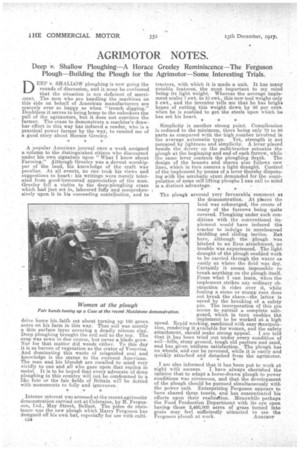AGRIMOTOR NOTES.
Page 22

If you've noticed an error in this article please click here to report it so we can fix it.
Deep 'v. Shallow Ploughing—A Horace Greeley Reminiscence—The Ferguson Plough—Building the Plough for the Agrimotor—Some Interesting Trials.
EEP v. SHALLOW ploughing is now going the
rounds of discussion, and it must be confessed that the situation is not deficient of merriaient. The men who are handling the machines on this side on behalf of American manufacturers are scarcely ever so happy as when "trench digging." Doubtless it serves to bring home to the onlookers the pull of the agrimotors, but it does not convince the farmer. The craze to demonstrate a machine's drawbar effort in this way has induced a reader, who is a practical power farmer by the way, to remind me of a good story about Horace Greeley.
A popular American journal once a week assigned a column to the distinguished citizen who discoursed under his own signature upon "What I know about Farming." Although Greeley was a devout worshipper of the land, his knowledge of the craft was peculiar. At all events, no one -took his views and suggestions to heart : his writingswere merely tolerated from good-humoured appreciation of the man. Greeley fell a victim to the deep-ploughing craze which had just set in, laboured fully and comprehensively upon it in his succeeding contribution, and to
drive home his.faith set about turning up 160 green acres on his farm in this way. That soil was merely a thin surface layer covering a deadly nitrous clay. Deep ploughing brought the evil soil to the top. The crop was sown in due course, but never a blade grew. Nor for that matter did weeds either. To this day it is as barren of vegetation as the crater of Vesuvius. And dominating this waste of misguided zeal and knowledge is the statue to the eminent American. The man and his blunde4 are recalled to mind very vividly to one and all who gaze upon that replica in metal. It is to be hoped that every advocate of deep ploughing in this country will not be condemned to a like fate or the fair fields of Britain will be dotted with monuments to folly and ignorance.
Intense interest was aroused at the recent agrimotbr demonstration carried out at Coleraine, by H. Fergusson, Ltd., May Street, Belfast. The pi6ce de resistance w,as the new plough which Harry Ferguson has designed off his own bat, especially for use with culti 0:o'S tractors, with which it is made a unit. It has many notable features, the most important to my mind being its light weight. Whereas the average implement scales 7 cwt. to 10 cwt., this new tool weighs only 2 cwt., and the inventor tells me that he has bright hopes of cutting this weight down by 50 per cent. when he is enabled to get the steels upon which he has set his heart.
Simplicity is another strong point. Complication is reduced to the minimum, there being only 70 to 80 parts as compared with the 'high number involved in the average automatic type. Yet, strength is not menaced by lightness and simplicity. A lever placed beside the driver on the eulti-tractor actuates the plough at the beginning and end of each furrow, while the same lever controls the ploughing depth. The design of the breasts and shares also follows new lines, which in turn assures a light draught. Control of the implement by means of a lever thereby dispensing with the acrobatic stunt demanded for the manipulation of some self-lifting ploughs I can call to mind is a distinct 'advantage.
The plough aroused yery favourable comment at
' the demonstration. At places the land was submerged, the crests of many of the furrows being quite covered. Ploughing under such conditions with the conventional implement would have induced the tractor to indulge in unrehearsed skidding and sliding tactics. But here, although the plough was hitched to an Eros attachment, no
_ trouble was experienced. The light draught of the plough enab,led work to be carried through the water as easily as where the field was dry. Certainly it seems impossible to break anything on the plough itself. From, what I can learn, when the implement strikes any ordinary obstruction it rides over it, while fouling a stone or stump root does not break the share—the latter is
saved by the breaking of a safety pin. The incorporation of this pin seems to extend a complete safeguard, which in turn enables the implement to be worked at a high: speed. Rapid working, combined with easy thanipulation, rendering it available for women, and the safety attachment, should make strong appeal. am n told that it has been tried out under every condition of • soil—hills, stony ground, tough old pasture and sand, and has given uniform satisfaction. The plough has no wheels, and can be reversed, while it is easily and quickly attached and detached from the agrimotor.
I am also informed that it has been put to work at night with success. I have always cherished the opinion that to adapt a horse-drawn plough to power conditions was erroneous, and that the development of the plough Aould be pursued simultaneously with the power unit. Enterprising Ferguson appears to have shared these tenets, and has concentrated his efforts upon their realiation. Meanwhile perhaps the Food Production Department with its eye upon Ina,ving those 2,400,000 acres of grass turned into grain may feel sufficiently attracted to see the
Ferguson plough at work. ACTRIMOT


























